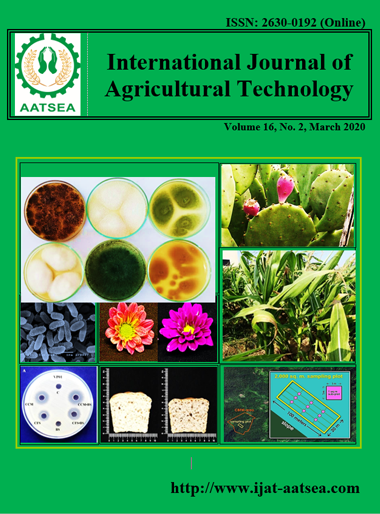Antimicrobial characteristics of wool fibers treated with chitosan-propolis nano composite and dyed with natural dye extracted from Red Prickly Pear
Main Article Content
Abstract
Nanotechnology provides a new concept for the improvement of the antimicrobial activity of the textile fibers. Natural dye extracted from red prickly pear using microwave heating was used for dyeing wool fibers. Chitosan-Propolis nano composite was applied as treatment on wool fibers before dyeing by using microwave and ultra sonication methods. The dye concentration and pH factors as well as color strength, color data and fastness properties of the dyed wool fibers were investigated. The results indicated that wool fibers pretreated with the tested nanomaterials exhibited better results than the untreated samples. Nano composite of chitosan and propolis showed antimicrobial activity against some pathogenic fungi and bacteria. The results indicated that the antimicrobial activity of the natural dye under investigation was good and it was enhanced by treatment with the nano composite. The morphological structure of the untreated and pretreated wool fibers was examined by scanning electron microscopy (SEM). The untreated wool fibers have a rough surface. The pretreated wool fibers were swollen as compared to the untreated fibers. The diameter of the fibers increased, and the surfaces became smooth and even.
Article Details

This work is licensed under a Creative Commons Attribution-NonCommercial-NoDerivatives 4.0 International License.
References
Ali, N. F., El-Khatib, E. M. and El-Mohamedy, R. S. R. (2015). The antimicrobial activity of pretreated silk fabrics dyed with natural dye. International Journal of Current Microbiology and Applied Sciences, 4:1166-1173.
Ali, N. F., El-Khatib, E. M., El-Mohamedy, R. S. R, Nassar, S. H. and El-Shemy, N. S. (2019). Dyeing properties of wool fibers dyed with rhubarb as natural dye via ultrasonic and conventional methods. Egyptian Journal of Chemistry, 62:119-130.
Ali, N. F., Mohamedy, R. S. R. E. L. and El- Khatib, E. M. (2011). Antimicrobial Activity of Wool Fabric Dye with Natural Dyes. Research Journal of Textile and Apperal, 15:1-10.
Ali-Shtayeha, M. S., Reem, Yaghmour, M. R., Faidi, Y. R., Salem, K. and Al-Nurid, M.A. (1998). Antimicrobial activity of 20 plants used in folkloric medicine in the Palestinian area. Journal of Ethnopharmacology, 60:265-271.
Ben-David, A. and Davidson, C. E. (2014). Estimation method for serial dilution experiments. Journal of Microbiological Methods, 107:214-221.
Dutta, P. K., Ravikumar, M. N. V. and Dutta, J. (2002). Chitin and chitosan for versatile applications. Journal of Macromolecular Science Part C – Polymer Reviews, 42:307-354.
El–Mohamedy, R. S. R. and Aboelfetoh, M. A. (2014a). Evaluation of antifungal activity of Moringa oleifera extracts as natural fungicide against some plant pathogenic fungi Invitro. Journal of Agricultural Technology, 10:963-982.
El–Mohamedy, R. S. R. and Aboelfetoh, M. A. (2014b). Antifungal activity of Moringa oleifera oil and seed extract against some plant pathogenic fungi. Middle East Journal of Agriculture Research, 3:242-249.
Fernandes Júnior, A., Balestrin, E. C., Betoni, J. E. C., Orsi, R. D. O., Cunha, M. D. L. R. D. and Montelli, A. C. (2005). Propolis: Anti-Staphylococcus aureus activity and synergism with antimicrobial drugs. Memórias do Instituto Oswaldo Cruz, 100:563-566.
Koukaras, E. N., Papadimitriou, S.A., Bikiaris, D.N. and Froudakis, G. E. (2012). Insight on the Formation of Chitosan Nanoparticles through Ionotropic Gelation with Tripolyphosphate. Molecular Pharmaceutics, 9:2856-2862.
Shin, Y., Yoo, D. I. and JANG, J. (2010). Molecular weight effect on antimicrobial activity of chitosan treated cotton fabrics. Journal of Applied Polymer Science, 80:2495-2591.
Simone-Finstrom, M., Borba, R. S., Wilson, M. and Spivak, M. (2017). Propolis counteracts some threats to honey bee health. Insects, 8:46.
Takaisi-Kikuni, N. B. and Schilcher, H. (1994). Electron microscopic and microcalorimetric investigations of the possible mechanism of the antibacterial action of a defined propolis provenance. Planta Medica, 60:222-227.
Wink, M. (2008). Evolutionary advantage and molecular modes of action of multi-component mixtures used inphytomedicine. Current Drug Metabolism, 9:996-1009.
Wink, M. (2015). Modes of action of herbal medicines and plant secondary metabolites. Medicines, 2:251-286.


